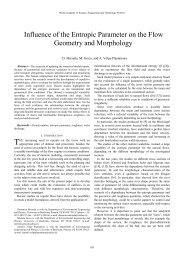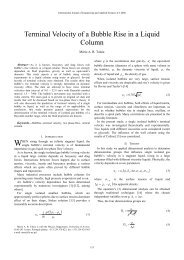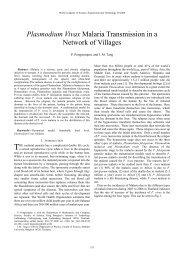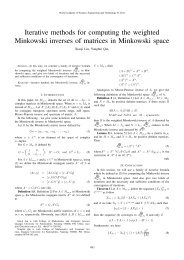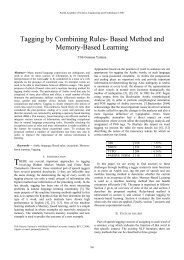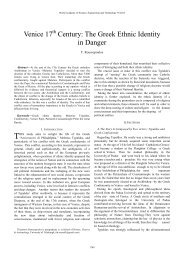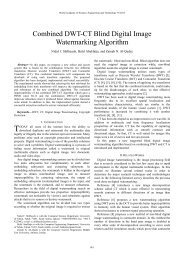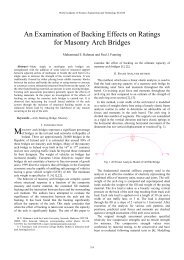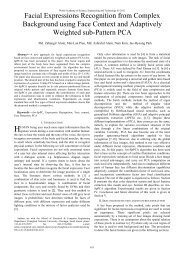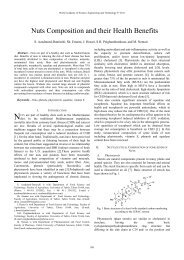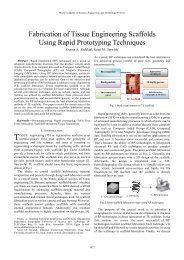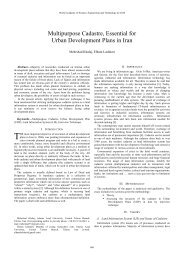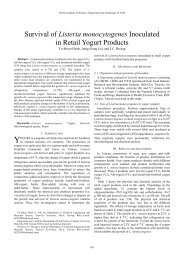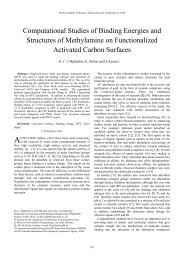Preparation and Characterization of Self Assembled Gold ...
Preparation and Characterization of Self Assembled Gold ...
Preparation and Characterization of Self Assembled Gold ...
Create successful ePaper yourself
Turn your PDF publications into a flip-book with our unique Google optimized e-Paper software.
Abstract—Wet chemistry methods are used to prepare the<br />
SiO2/Au nanoshells. The purpose <strong>of</strong> this research was to synthesize<br />
gold coated SiO2 nanoshells for biomedical applications. Tunable<br />
nanoshells were prepared by using different colloidal concentrations.<br />
The nanoshells are characterized by FTIR, XRD, UV-Vis<br />
spectroscopy <strong>and</strong> atomic force microscopy (AFM). The FTIR results<br />
confirmed the functionalization <strong>of</strong> the surfaces <strong>of</strong> silica nanoparticles<br />
with NH2 terminal groups. A tunable absorption was observed<br />
between 470-600 nm with a maximum range <strong>of</strong> 530-560 nm. Based<br />
on the XRD results three main peaks <strong>of</strong> Au (111), (200) <strong>and</strong> (220)<br />
were identified. Also AFM results showed that the silica core<br />
diameter was about 100 nm <strong>and</strong> the thickness <strong>of</strong> gold shell about 10<br />
nm.<br />
Keywords—<strong>Gold</strong> nanoshells, Synthesis, UV-vis spectroscopy,<br />
XRD, AFM<br />
I. INTRODUCTION<br />
N recent years noble nanoparticles <strong>and</strong> nanoshells have<br />
I been focus <strong>of</strong> many research fields including: Biomedical,<br />
optoelectronics, chemical sensors <strong>and</strong> surface – enhanced<br />
Raman scattering (SERS) [1]. The optical property <strong>of</strong><br />
nanoshells is dominated by the response <strong>of</strong> the metal’s<br />
conduction electrons, particularly the surface plasmon<br />
resonance (SPR)[2]. Excitation <strong>of</strong> surface plasmons via<br />
photons, requires specific condition that are defined by their<br />
dispersion relation:<br />
k sp<br />
ω<br />
=<br />
c<br />
ε1ε2 ε + ε<br />
1 2<br />
Where ksp is the surface plasmon wave vector, ω is the<br />
frequency <strong>of</strong> light <strong>and</strong> ε1, ε2 represent the dielectric <strong>of</strong> medium<br />
1(here SiO2) <strong>and</strong> 2 (Au) respectively. It should be noted that<br />
εdiel is the (purely real) dielectric constant, <strong>and</strong> εmet (Au) =<br />
εr+ iεi is the complex dielectric constant <strong>of</strong> the metallic<br />
nanoparticles. The real part (εr) determines the degree to<br />
which the metal polarizes in response to an applied external<br />
M. E. Khosroshahi is with the Laser <strong>and</strong> Nanobiophotonics Lab.,<br />
Biomaterials Group, Faculty <strong>of</strong> Biomedical Engineering, Amirkabir<br />
University <strong>of</strong> Technology, Tehran, Iran (Corresponding author to provide<br />
phone: +982164542398;fax:+982166468186;e-mail: khosro @ aut .ac .ir).<br />
M. S. Nourbakhsh is with the Laser <strong>and</strong> Nanobiophotonics Lab.,<br />
Biomaterials Group, Faculty <strong>of</strong> Biomedical Engineering, Amirkabir<br />
University <strong>of</strong> Technology, Tehran, Iran (e-mail: s_nourbakhsh@ aut .ac .ir).<br />
World Academy <strong>of</strong> Science, Engineering <strong>and</strong> Technology 40 2010<br />
<strong>Preparation</strong> <strong>and</strong> <strong>Characterization</strong> <strong>of</strong> <strong>Self</strong><br />
<strong>Assembled</strong> <strong>Gold</strong> Nanoparticles on Amino<br />
Functionalized SiO2 Dielectric Core<br />
M.E.khosroshahi ,M.S.Nourbakhsh<br />
(1)<br />
353<br />
electric field <strong>and</strong> the imaginary part, iεi, quantifies the relative<br />
phase shift <strong>of</strong> this induced polarization with respect to the<br />
external field <strong>and</strong> it include losses (e.g. ohmic loss as heat).<br />
For solid spherical nanoparticles the wavelength at which the<br />
plasmon resonance occurs is only weakly dependant on the<br />
particle size. For nanoshells, the plasmon resonance<br />
wavelengths depends on the relative sizes <strong>of</strong> the core <strong>and</strong> shell<br />
<strong>and</strong> can be placed from 600- 2500 nm using silica core <strong>and</strong><br />
gold shells[3].<br />
Novel optical effects are expected by appropriately<br />
arranging metal particles on the surface <strong>of</strong> insulating cores <strong>of</strong><br />
spherical shape, so as to compose, on a nanometer scale, coreshell<br />
structures. Optical resonances from near-infrared to the<br />
visible range may then be tuned by adjusting the core size,<br />
shell thickness <strong>and</strong> type <strong>of</strong> metal <strong>and</strong>/or core material [4].<br />
Core-shell structures have been intensively studied very<br />
recently, in particular since such structures exhibit peculiar<br />
properties which make them attractive for applications in<br />
optical <strong>and</strong> biological sensors <strong>and</strong> in optoelectronics [5]. For<br />
practical reasons, solution methods, such as the deposition <strong>of</strong><br />
nanoparticles from a colloidal route <strong>of</strong> synthesis or particle<br />
formation directly on the surface by appropriate processes, are<br />
preferred. The first route includes electrostatic deposition <strong>of</strong><br />
colloidal particles by means <strong>of</strong> adhesives such as poly<br />
electrolytes covering the oxide surface [6] <strong>and</strong> lig<strong>and</strong>mediated<br />
immobilization <strong>of</strong> metal colloids on functionalized<br />
oxide surfaces [2]. The second route includes controlled<br />
chemical reduction or photochemical reduction [7].The aim <strong>of</strong><br />
producing core-shell structures requires one to achieve a high<br />
nucleation but low growth rate, so as to obtain a high number<br />
density <strong>of</strong> metal nanoparticles without the formation <strong>of</strong><br />
aggregates. Further nanoparticles coating from<br />
complementary processes to form continuous metal nanoshells<br />
may utilize the previously formed particles serving as seeds<br />
which catalyze metal deposition without nucleation <strong>of</strong> new<br />
particles [8]. Such multi-step processing includes some<br />
prospects <strong>of</strong> fabricating bimetallic structures by varying the<br />
metal precursor employed.<br />
In this study we report synthesis <strong>and</strong> characterization <strong>of</strong><br />
binary SiO2/Au nanoshells for clinical applications where<br />
surface plasmon-based thermal effect plays a crucial role.
II. MATERIALS AND METHODS<br />
Hydrogen tetrachloraurate (HAuCl4) (99.9%), tetraethyl<br />
orthosilicate (TOES) (99.9%), 3-aminopropyltrimethoxy<br />
silane(APTMS),Tetrakis hydroxymethyl phosphonim chloride<br />
(THPC) (80% solution in water), Potassium carbonate (99%),<br />
formaldehyde, ammonium hydroxide solution (33%NH3) <strong>and</strong><br />
ethanol (99%), HPLC grade water <strong>and</strong> Sodium Hydroxide<br />
(99%) were obtained from Sigma- Aldrich Co. Silica<br />
nanoparticles prepared using following method: 3mL <strong>of</strong><br />
ammonia was first added to 50mL <strong>of</strong> absolute ethanol, <strong>and</strong><br />
then the mixture was stirred vigorously ; different amounts<br />
(1mL (sample A), 1.5mL (sample B)) <strong>of</strong> TEOS were added<br />
drop wise. The induction period was approximately 45<br />
minutes that the solution color became cloudy as silica<br />
nanoparticles were grown <strong>and</strong> eventually turned opaque<br />
white. 25μL <strong>of</strong> APTMS was then added to 50 mL <strong>of</strong> the<br />
vigorously stirred silica nanoparticles solution <strong>and</strong> allowed to<br />
react for 2 hours. The APTMS coated silica nanoparticles<br />
were purified by centrifuging at 3500 rpm <strong>and</strong> redispersion in<br />
ethanol. For preparation <strong>of</strong> colloidal gold nanoparticles,<br />
0.5mL <strong>of</strong> 1M NaOH <strong>and</strong> 1 mL <strong>of</strong> THPC solution (prepared by<br />
adding 12 µL <strong>of</strong> 80% THPC to 1 mL <strong>of</strong> HPLC grade water)<br />
were added to a 45 mL <strong>of</strong> HPLC grade water. The solution<br />
was stirred vigorously for 5 minutes. After this process 2 mL<br />
<strong>of</strong> 1% HAuCl4 in water was added to the stirred solution.<br />
THPC gold solution preparation produced a brown color<br />
solution within 2-3 seconds after addition <strong>of</strong> chloroauric acid.<br />
For attachment <strong>of</strong> colloidal gold to nanosilica particles,<br />
1mL <strong>of</strong> APTMS-functionalized nanosilica particles dispersed<br />
in ethanol was added to 10 mL <strong>of</strong> gold colloid (~7×10 14<br />
particles / mL) in a tube. The tube was shaken for 5 minutes<br />
<strong>and</strong> then was left to settle down for 2 hour. The mixture was<br />
subsequently centrifuged at 2000 rpm <strong>and</strong> a red color pellet<br />
precipitated at the bottom <strong>of</strong> the tube. The supernatant was<br />
removed <strong>and</strong> the remaining red-colour pellet redispersed in<br />
HPLC grade water. The purified Au/APTMS/nanosilica<br />
particles then redispersed in 5 mL <strong>of</strong> HPLC grade water.<br />
For growing the gold over the Au/APTMS/silica<br />
nanoparticles, 25mg <strong>of</strong> potassium carbonate was dissolved in<br />
100mL water. After 10 minutes <strong>of</strong> stirring, 1.5 mL <strong>of</strong><br />
1%HAuCl4 was added. This solution was initially yellow <strong>and</strong><br />
after 30 minutes became colorless. 0.5 mL <strong>of</strong> the solution<br />
containing Au/APTMS/nanosilica was added to the colorless<br />
solution. After addition <strong>of</strong> 20µL <strong>of</strong> formaldehyde the colorless<br />
solution became purple. The nanoshells were centrifuged <strong>and</strong><br />
redispersed in HPLC water for preparation <strong>of</strong> final product.<br />
The ultraviolet/visible (UV/visible) extinction spectra <strong>of</strong> the<br />
nanoparticles were measured in solution using the UV/VISspectrophotometer<br />
(Philips PU 8620) in the wavelength range<br />
<strong>of</strong> 190 to 900 nm with the appropriate mixture <strong>of</strong> ethanol <strong>and</strong><br />
water as a reference. The surface topography <strong>and</strong> roughness as<br />
well as the size <strong>of</strong> nanoshells were studied by AFM (Dual<br />
scope/ Raster scope C26, DME, Denmark). Mid-infrared<br />
spectra <strong>of</strong> absorbance peaks <strong>of</strong> SiO2, APTMS/Silica <strong>and</strong><br />
Au/APTMS/ SiO2 were obtained by transmission mode <strong>of</strong><br />
Fourier Transform infrared (FTIR; Brucker, EQUINOX 55,<br />
Germany).<br />
World Academy <strong>of</strong> Science, Engineering <strong>and</strong> Technology 40 2010<br />
354<br />
III. RESULTS AND DISCUSSION<br />
Silica (SiO2) is a popular material to form core shell particles<br />
because <strong>of</strong> its extraordinary stability against coagulation. Its<br />
non-coagulating nature is due to very low value <strong>of</strong> Hamaker<br />
constant, which defines the Van der Waal forces <strong>of</strong> attraction<br />
among the particles <strong>and</strong> the medium [9]. It is also chemically<br />
inert, optically transparent <strong>and</strong> does not affect redox reactions<br />
at core surfaces [10]. For various purposes it is desirable that<br />
particles remain well dispersed in the medium which can be<br />
achieved by suitably coating them to form an encapsulating<br />
shell. It is worth mentioning that the synthesizing <strong>of</strong> SiO2<br />
nanoparticles may take place via the procedure developed by<br />
Stober et al. [11] This method involves hydrolysis <strong>and</strong><br />
successive condensation <strong>of</strong> TEOS (Si (C2H5O) 4) in alcoholic<br />
medium.<br />
Si(OC2H5)4 + 4H2O → Si(OH) 4 + 4C2H5OH (2)<br />
Si (OH) 4 → SiO2 + 2H2O (3)<br />
UV-visible spectra recorded for two different samples are<br />
shown in fig.1. For gold nanoparticles synthesized by 1mL<br />
TEOS a peak at about 535 nm was observed. However, when<br />
1.5mL was used the peak showed a red-shift at about 556 nm.<br />
This is thought to be associated with a SPR phenomenon. The<br />
resonance peak position depends on the plasmon interaction<br />
between separate inner <strong>and</strong> outer gold layers. As it can be seen<br />
in this figure, the increasing addition <strong>of</strong> TEOS could<br />
efficiently cause the optical plasmon peaks to undergo a redshift,<br />
which is consistent with the theoretical predictions <strong>of</strong><br />
optical properties <strong>of</strong> metal coated particles. As the nanoshell<br />
growth progresses their optical plasmon peak is slightly redshifted.<br />
Also the peak broadening is similar to the results<br />
observed by Wiesner [12] in spectroscopic studies <strong>of</strong> gold<br />
platelets in solution. In their case, the growing silica layer<br />
began to coalesce <strong>and</strong> encapsulated the different amounts <strong>of</strong><br />
gold nanoparticles.<br />
Fig.1 UV-visible spectroscopy <strong>of</strong> gold nanoshell synthesized<br />
by different amount <strong>of</strong> TEOS<br />
This phenomenon suggests that the silica core is completely<br />
covered by gold layer <strong>and</strong> its absorption spectra are function<br />
<strong>of</strong> the addition ratios <strong>of</strong> TEOS. Furthermore, the complete<br />
synthesized nanoshells, whose optical plasmon resonance<br />
peak ranges in the 500- 600 nm regions, can be used as a<br />
powerful tool in bio-imaging <strong>and</strong> bio sensing applications.<br />
The optical absorption spectra shown in this figure are
elatively broad compared with that <strong>of</strong> pure gold colloid.<br />
According to Mie scattering theory, the nanoshells geometry<br />
can quantitatively accounts for the observed plasmon<br />
resonance shifts <strong>and</strong> line-widths. In addition, the plasmon<br />
line-width is dominated by surface electron scattering [13].<br />
Infrared spectroscopy <strong>of</strong>fers a wealth <strong>of</strong> information regarding<br />
the structure <strong>of</strong> the surface <strong>of</strong> the nanoparticles. In particular,<br />
IR spectroscopy affords insight into the order <strong>and</strong> packing <strong>of</strong><br />
the surface chains. The surface <strong>of</strong> the core particles is <strong>of</strong>ten<br />
modified with bi-functional molecules to enhance coverage <strong>of</strong><br />
shell material on their surfaces [14]. Surface <strong>of</strong> core particles<br />
such as silica can be modified using bi-functional organic<br />
molecules such as APTMS. This molecule has a methoxy<br />
group at one end, <strong>and</strong> NH group at the other end. APTMS<br />
forms a covalent bond with silica particles through the OH<br />
group <strong>and</strong> their surface becomes NH-terminated. The FTIR<br />
spectra <strong>of</strong> SiO2 functionalized with APTMS <strong>and</strong> gold coated<br />
nanoparticles for sample A is shown in fig.2. The main peaks<br />
are 3431 cm -1 (NH2 asymmetric stretch), 1634 cm -1 (O-H<br />
bending) <strong>and</strong> 466 cm -1 for Si-O-Si bending mode. The shells<br />
showed Si–O–Si symmetric stretching at 801cm -1 <strong>and</strong><br />
characteristic Si–O–Si asymmetric stretching at around 1100<br />
cm -1 respectively [15].<br />
Fig.2 FTIR <strong>of</strong> SiO2 functionalized with APTMS for sample A<br />
In order to indicate identity <strong>of</strong> the particles, X-ray<br />
diffraction (XRD) analysis was performed. The XRD pattern<br />
<strong>of</strong> nanoshells shown in Fig.3 exhibited characteristic<br />
reflections <strong>of</strong> fcc gold (JCPDS No.04-0784). The diffraction<br />
features appearing at 2θ = 38.20°, 44.41°, <strong>and</strong> 64.54° which<br />
respectively corresponds to the (111), (200) <strong>and</strong> (220) planes<br />
<strong>of</strong> the st<strong>and</strong>ard cubic phase <strong>of</strong> Au.<br />
Fig.3 XRD spectra <strong>of</strong> gold nanoshells<br />
World Academy <strong>of</strong> Science, Engineering <strong>and</strong> Technology 40 2010<br />
355<br />
By varying relative ratio <strong>of</strong> TEOS to solvent we could<br />
synthesize these particles in various sizes. Reduction in TEOS<br />
concentration led to the formation <strong>of</strong> smaller particles. Silica<br />
particles synthesized by this procedure were amorphous <strong>and</strong><br />
porous. Fig. 4a shows an AFM image <strong>of</strong> functionalized silica<br />
nanoparticles synthesized by the procedure described earlier<br />
in the material <strong>and</strong> methods section. An example <strong>of</strong> Au coated<br />
SiO2 nanoshell is shown in fig. 4b. Small colloids <strong>of</strong> the gold<br />
particles are attached to APTMS – functionalized silica<br />
nanoparticles core which were then used to template the<br />
growth <strong>of</strong> gold over layer. The size <strong>of</strong> the nanoshells<br />
determined by AFM ranged between 90 <strong>and</strong> 110 nm. These<br />
images provided useful information about surface topography<br />
<strong>and</strong> the size <strong>of</strong> the gold nanoparticles with well defined<br />
clarity, which effectively is correlated to optical absorption<br />
spectra.<br />
Fig.4 AFM photographs <strong>of</strong> surface topography <strong>of</strong> SiO2 core (a) <strong>and</strong><br />
SiO2/Au nanoshells
IV. CONCLUSION<br />
<strong>Gold</strong> nanoshells were deposited on the surfaces <strong>of</strong> silica<br />
core <strong>and</strong> their chemical <strong>and</strong> optical properties were<br />
investigated. The unique, tunable <strong>and</strong> optical responses <strong>of</strong><br />
gold nanoshells are most desirable as exogenous agent for<br />
biophotonics applications. In summary, we have demonstrated<br />
that gold nanoshells with tunable thickness can be fabricated<br />
on silica dielectric with diameters ranging from 90 to 110nm,<br />
where the shell thickness <strong>and</strong> roughness were controlled by<br />
the amount <strong>of</strong> TEOS <strong>and</strong> checked by AFM. Higher<br />
concentration <strong>of</strong> gold nanoparticles provided a higher<br />
temperature rise. Based on the gold layer thickness <strong>and</strong> the<br />
LSPR effect the degree <strong>of</strong> light absorption varied between<br />
470-600 nm. A variety <strong>of</strong> parameters can influence the selfassembly<br />
<strong>of</strong> gold nanoparticles into clusters attached to the<br />
surfaces <strong>of</strong> functionalized silica nanoparticles which in this<br />
case hydrophilic functional groups such as NH2 led to the<br />
attachment <strong>of</strong> gold nanoparticles.<br />
[1]<br />
REFERENCES<br />
S.R.Sershen, S.L. Westcott, J.L.West, N.J. Halas, “An opto-mechanical<br />
nanoshell–polymer composite,” Appl. Phys. B,vol.73,no.4, pp.379–381 ,<br />
2001.<br />
[2] S.J. Oldenburg, R.D. Averitt, S.L.Westcott , N.J.Halas.<br />
[3]<br />
“Nanoengineering <strong>of</strong> optical resonances,” Chem. Phys. Lett. , vol. 288,<br />
no.2, pp.243–247 1998.<br />
Y .Shinong, Y .Wang, T .Wen, J .Zhu, “A study on the optical<br />
absorption properties <strong>of</strong> dielectric-mediated gold nanoshells,” Physica<br />
E., vol.33 no.1, pp.139–143, 2006.<br />
[4] S. Westcott, S. Oldenburg, T. R. Lee, <strong>and</strong> N. J. Halas, “Construction <strong>of</strong><br />
Simple <strong>Gold</strong> Nanoparticle Aggregates with Controlled Plasmon-<br />
Plasmon Interactions”, Chem. Phys. Lett,., vol, 300 ,no.5, pp. 651-655,<br />
1999.<br />
[5] S. R. Sershen, S. L. Westcott ,N. J. Halas, “Temperature-sensitive<br />
polymer-nanoshell composites for photothermally modulated drug<br />
delivery ” J. Biomed. Mater. Res, Part A. vol. 51, no.3 , pp.293-298.<br />
[6] M. Giersig, L., T. Ung, P.Mulvaney , D. Su, Phys. Chem. 1997, 101,<br />
1617.<br />
[7] K. Okitsu, Y. Mizukoshi, H. B<strong>and</strong>ow , Y. Maeda, “Formation <strong>of</strong> noble<br />
metal particles by ultrasonic irradiation” Ultrasonics Sonochem, vol.3 ,<br />
no. 3, pp.249- 251,1996.<br />
[8] T. K. Sau, A. Pal, N. R. Jana, Z. L. Wang , T. Pal, “Size controlled<br />
synthesis <strong>of</strong> gold nanoparticles using photochemically prepared seed<br />
particles”, J. Nanoparticle Res. vol. 3, vol.257-261. 2001,<br />
[9] L.M.Liz-Marzan, M.A.Correa-Duarte, P. Mulvaney <strong>and</strong> N. A Kotov, “<br />
Core –shell nanoparticles <strong>and</strong> assemblies there<strong>of</strong>” H<strong>and</strong> Book <strong>of</strong><br />
Surfaces <strong>and</strong> Interfaces <strong>of</strong> Materials , vol. 3, Ch. 5, pp. 189–237, 2001.<br />
[10] T. Ung , L.M. Liz-Marzan, P. Mulvaney, “Controlled method for silica<br />
coating <strong>of</strong> silver colloids. Influence <strong>of</strong> coating on the rate <strong>of</strong> chemical<br />
reactions”, Langmuir, vol.14, no.14, pp.3740–3748, 1998.<br />
[11] W.Stober, A.Fink, E.Bohn, “Controlled growth <strong>of</strong> monodisperse silica<br />
spheres in the micron size range”. J. Colloid Interface Sci., vol.26, no.1,<br />
pp.62–69,1968.<br />
[12] J.Wiesner, A.Wokaun, H. H<strong>of</strong>fmann , “Surface enhanced Raman<br />
spectroscopy (SERS) <strong>of</strong> surfactants adsorbed to colloidal particles”,<br />
Progress in Colloid & Polymer Science,vol.76 ,pp. 271- 277 ,1988.<br />
[13] H.C.Lu,I.S.Tsai , Y.H.Lin. “Development <strong>of</strong> near infrared responsive<br />
material based on silica encapsulated gold nanoparticles”. Journal <strong>of</strong><br />
Physics: Conference Series , 188 , (2009)<br />
[14] A. Van Blaaderen, A. J.Vrij, “Synthesis <strong>and</strong> characterization <strong>of</strong> mono<br />
disperse colloidal organo-silica spheres”. J. Colloid Interface Sci., vol.<br />
156 ,no.1, pp.1–18,1993.<br />
[15] A. Patra, E. Sominska, S. Ramesh, Y.Koltypin. “Sonochemical<br />
preparation <strong>and</strong> characterization <strong>of</strong> Eu203 <strong>and</strong> Tb203 doped in <strong>and</strong><br />
coated on silica <strong>and</strong> alumina nanoparticles” , J. Phys. Chem.B, vol.103,<br />
no.17, pp. 3361–3365, 1999.<br />
World Academy <strong>of</strong> Science, Engineering <strong>and</strong> Technology 40 2010<br />
356



